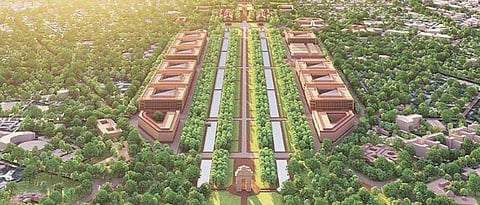

The Supreme Court Tuesday refused to interdict the Central Government's Central Vista project.
A three-judge bench by a majority of 2:1 held that there was no infirmity in the grant of "No Objection" by the Central Vista Committee (CVC); approval by the Delhi Urban Art Commission (DUAC) as per the DUAC Act, 1973; and "Prior approval" by the Heritage Conservation Committee (HCC) under clause 1.12 of the Building Byelaws for Delhi, 2016.
The majority judgment authored by Justice AM Khanwilkar also held that the exercise of power by the Central Government under Section 11A(2) of the DDA Act, 1957 was just and proper. It, thus, confirmed the notification issued on March 20, 2020 regarding the change in land use of plot Nos. 2 to 8 in the Master Plan of Delhi, 2021/Zonal Development Plan for Zone-D and Zone-C.
Justice Khanwikar joined by Justice Dinesh Maheshwari also upheld the recommendation of Environmental Clearance (EC) by the Expert Appraisal Committee (EAC) and grant thereof by the Ministry of Environment, Forest(MoEF).
The judges' majority also held that the stage of prior permission under clause 1.3 of the Building Bye-Laws of the Heritage Conservation Committee (HCC), was the stage when actual development/redevelopment etc. work was to commence and not the incipient stage of planning and formalisation of the Project.
It, thus, directed the respondents to obtain the prior permission of the designated Authority before actually starting any development/redevelopment work on the stated plots/structures/precincts governed by the heritage laws including on plot No. 118, if already not obtained.
Justice Sanjiv Khanna dissented with the majority opinion on the aspects of public participation on the interpretation of the statutory provisions, failure to take prior approval of the Heritage Conservation Committee and the order passed by the Expert Appraisal Committee. He, however, agreed with the majority order on the aspects of Notice inviting Bid, the award of consultancy, and the order of the Urban Arts Commission, as a standalone and independent order.
"Delegation of the power to legislate and govern to elected representatives is not meant to deny the citizenry's right to know and be informed", penned Justice Khanna in his dissenting opinion.
While quashing the notification of modification/change of the land use dated March, 28 2020, Justice Khanna directed the Central Government/Authority to put in the public domain on the web, intelligible and adequate information along with drawings, layout plans, with explanatory memorandum etc. within a period of 7 days.
Justice Khanna also quashed the order of the EAC dated April 22, 2020, and the environment clearance by the Ministry of Environment and Forest dated June 17, 2020, and remitted them to the EAC with a request that they decide the question on environment clearance within a period of 30 days from the date of receiving a copy of this order, without awaiting the decision on the question of change/modification of land use. A speaking and reasoned order would have to be passed, he ordered.
The Court was ruling on a batch of petitions questioning the Central Vista Project. It was, inter-alia, contended that the existing Parliament House and Central Vista were continuing and living heritage which must be preserved and protected for future generations.
"Re-development of nearly 80 acres of land, demolition of National Museum and construction of new Parliament will permanently affect the iconic character, skyline, layout, and the architectural harmony of the Central Vista. It would cause irreplaceable and non-revocable harm and damage Garde 1 heritage buildings and precincts", the petitioners contended.
The petitioner also contended that the development if permitted would violate Articles 49 and 51(c) of the Directive Principles of State Policy. Further, the Doctrine of Public Trust applied to historically significant buildings/precincts and properties of special consequence.
According to the government "The Central Vista of New Delhi houses Rashtrapati Bhawan, Parliament House, North and South Block, India Gate, National Archives etc. All these iconic buildings were constructed before 1931, the year in which the new capital was inaugurated. The other office buildings were built on various plots subsequently to address the office requirements of Central Ministries and Departments in an unplanned manner. Parliament House building came up in 1927 and is declared Heritage building. Its facilities and infrastructure are inadequate to meet the current demand. Therefore, there is an imperative need to construct a new state-of-art Parliament building in close vicinity. This proposal may address not only the space requirement but may result in an iconic structure as a symbol of democracy".
The objectives of the project, according to the government, include upgrading Parliament's space and facilities; consolidating, rationalizing and synergizing government functioning; refurbishing and better equipping Central Vista Avenue; strengthening cultural institutions in Central Vista.
http://theleaflet.in/wp-content/uploads/2021/01/8430_2020_34_1501_25340_Judgement_05-Jan-2021.pdf